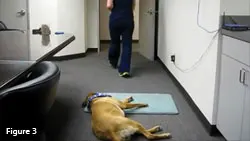Acral Lick Dermatitis: Behavioral Solutions

In the June 2012 issue, Dr. Karin Beale addressed acral lick dermatitis (ie, lick granulomas) from a dermatologist’s perspective. This article presents a behaviorist’s view of the same affliction.
Canine acral lick dermatitis (ALD) is a relatively common condition in which excessive licking can lead to raised, firm, alopecic, eroded to ulcerated lesions that are generally on the dorsal aspect of a forelimb as well as metatarsal/tarsal areas. ALD is multifactorial but can often be caused by an underlying medical component. If ALD persists after medical causes have been controlled or eliminated, it can be considered a stereotypic behavior.
ALD in dogs has served as a model for compulsive disorder in humans.1 Neuroimaging and pharmacologic studies have demonstrated evidence of dysfunction in the prefrontal–basal ganglia–thalamic circuits and the serotonergic neurotransmitter systems in both human and veterinary obsessive-compulsive patients.2 Regardless of origin, ALD can be difficult and frustrating to treat.
Prognosis for controlling or resolving ALD is highly variable, as chronic severe lesions are often difficult to resolve. Relapse may be common, particularly if medication is withdrawn and/or environmental stressors are not adequately addressed. If owners are attentive to enrichment and behavior modification, affected dogs can often be cured.
Assess patient health statusPhysical Examination
Complete physical examination to identify ancillary health issues that may exacerbate or complicate ALD treatment
Determine extent, location, and severity of the ALD lesion; lesions in certain locations can help define the underlying cause (eg, arthritis, abdominal pain, trauma)
Diagnostics & Imaging
Perform minimum database in anticipation of psychopharmacologic use
Perform ancillary diagnostics
As appropriate for patient’s age, breed, and health status
Rule out medical disorders (including any that might complicate wound healing)
Rule out endocrine disorders (eg, hypothyroidism, hyperadrenocorticism)
As necessary, including skin scraping, fungal culture, biopsy, culture and sensitivity testing, radiography
Assess underlying osseous change ± radiographs
Assess patient behavioral history
In a behavioral diagnosis, ALD is often attributed to boredom
However, assessment inadequately describes degree of behavioral pathology generally necessary for self-mutilation
Compulsive behavior is customarily attributed to environmental stress, conflict, or chronic environmental deprivation (eg, confinement)3
Frequency, time of occurrence, and duration can influence treatment
Information About Dog’s Routine
Diet and frequency of feeding
Time spent indoors vs outdoors
Type and extent of physical, aerobic exercise (including off-property excursions)
Other animals in the home and their relationship with the patient
Location where the patient sleeps and spends time when left alone
Toys or activities available and whether they are used
Information About Dog’s Behavior
Consider additional owner complaints about the dog’s behavior before delineating the treatment program (See Figure 1)
Aggression (eg, toward people, animals)
Anxiety (eg, separation, noise, general)

Before deciding the best treatment protocol, practitioners need to consider all information related to the individual dog’s routine and behavior, including owner complaints such as (Figure 1A, above) aggression toward people or (Figure 1B) extreme anxiety behavior displayed as a result of noise/storm phobia.
Institute management to prevent further injury
Facilitate healing with immediate control of excessive licking
Apply local bandages ± concurrent application of bitter substances
Apply restraint collar
Behavioral profile can influence the nature and type of restraint device
Fearful, anxious dogs may do poorly with large (especially opaque) Elizabethan collars
Initiate treatment of local lesion
Administer appropriate long-term systemic antibiotics based on deep culture and sensitivity testing, especially if considerable granulation tissue is present
Administer topical products to reduce inflammation and irritation
Consider laser therapy
Consider allergy potential

Implement environmental changes
Note that environmental deprivation and minimal opportunities for species-appropriate behaviors often contribute to compulsive or repetitive behaviors
Encourage physical, aerobic exercise appropriate to age, breed, and health status
Recommend excursions unless the dog’s behavior (eg, uncontrollable aggression in public) prevents it
Initiate use of food-dispensing toys and activities (See Figure 2)
Develop opportunities for breed-specific behavior (eg, digging pits for terriers, herding activities for herding breeds, lure coursing for sight hounds)
Encourage canine sports (eg, rally, agility, tracking)
Encourage sufficient and quality socialization with humans
Encourage moving outdoor dogs indoors or providing more opportunities for them to socialize with family members
Proactive environmental modification includes designated areas for appropriate play activities, along with food-dispensing devices and other toys. (Figure 2)
Institute behavior modification for environmental & social stressors
Keep the dog isolated from situations that incite anxious and/or aggressive behavior to prevent rehearsal of negative behavior patterns
Consistently reinforce relaxed behavior with attention, praise, small food treats, or favored activities (eg, fetch, walks)
Recommend dog–owner interactions in which the owner only interacts with the dog when it is calm (ie, reinforcing the behavior)
Train basic obedience cues using positive reinforcement to enrich and facilitate relaxation
Reinforce alternative desirable behaviors (bone chewing, play, resting, playing with other animals) to reduce time spent licking excessively
Begin contextual relaxation conditioning
Reinforce behaviors for relaxation in the presence of controllable cues (eg, special training mat; See Figure 3)
Calm behaviors include sighing, moderate blinking, lateral recumbency, resting with head on the ground, observable reductions in skeletal muscle tension
Relaxation training is used to countercondition the dog to environmental stressors (eg, other animals, visitors, storms/noises, gradual owner departures)4
Positive punishment using electronic shock may be successful in some cases5; however, this approach is controversial

Contextual relaxation conditioning involves behavior reinforcement based on controllable cues. Special training mats, such as the one shown here, help reinforce alternative desirable behaviors. (Figure 3)
Initiate psychopharmacologic treatment
Start treatment; reevaluate after 4 weeks
Titrate if little or no response
Administer anticompulsive medications with serotonergic modulation1,6,7
Clomipramine at 2–3 mg/kg q12h
Fluoxetine at 1–2 mg/kg q6h
Sertraline at 1–3 mg/kg q6–12h
Opioid antagonists (naltrexone, nalmefene) have proven useful in some ALD cases8
Continue medication for >3 months past resolution of lesion(s) and behavioral signs
Wean medications slowly; longer treatments require slower weaning to prevent relapse
Monitor treatment response
Track response to medications closely and frequently, especially within 6–8 weeks after initiation
Adverse reactions to serotonergic agents generally arise within the first 6 weeks
Sedation, appetite suppression
Agitation, restlessness
Increased fearfulness, noise hypersensitivity
Journal (eg, written, verbal) behavior issues to allow objective assessment of treatment response
Catalog size of dermatologic lesions on weekly or monthly basis
TAKE-HOME POINTS
Immediate control of excessive licking is necessary to facilitate healing
Before planning treatment, consider additional concerns (eg, aggression, anxiety)
Human socialization, breed-specific activities, and obedience training
ALD = acral lick dermatitis
Related Articles:Compulsive Behaviors in DogsChewing in Dogs
Lore I. Haug, DVM, MS, DACVB, owns and practices at Texas Veterinary Behavior Services in Sugar Land, Texas. She is certified by the International Association of Animal Behavior Consultants; in addition, she is a member of both the American Veterinary Society of Animal Behavior and the Association of Pet Dog Trainers. Dr. Haug completed an internship at Louisiana State University and earned her MS and DVM from Texas A&M University, where she also completed her residency.